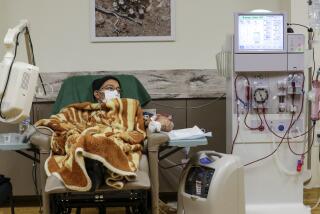Dr. Belding H. Scribner, 82; Physician Made Dialysis a Routine Treatment for Millions
- Share via
Dr. Belding H. Scribner, the Seattle physician who transformed kidney dialysis from a good theoretical idea to a practical treatment that saved millions of lives, died Thursday at 82.
Scribner’s body was found floating in the city’s Portage Bay, where he lived with his wife in a houseboat. Seattle police said Friday that Scribner drowned, but that there was no sign of foul play. His wife, Ethel, said he had suffered from heart disease and osteoporosis and had been sick for some time.
Scribner did not invent kidney dialysis, but his work made it a routine treatment that could be used for long periods. An intuitive and compassionate physician, he proved to be the right person in the right place at the right time.
For his achievement, Scribner shared the 2002 Albert Lasker Award for Clinical Medical Research with Dr. Willem J. Kolff of the University of Utah School of Medicine. The Lasker award is generally considered second only to the Nobel Prize for Medicine, and its recipients often later receive the Nobel.
The Lasker citation said Kolff and Scribner’s work “changed kidney failure from a fatal to a treatable disease, prolonging the useful lives of millions of people.” With their work, the prognosis for end-stage kidney disease “flipped from 90% fatal to 90% survivable,” the citation said.
The kidney’s main function is to remove toxic byproducts of metabolism from the bloodstream. When the organ fails, these substances build up and slowly poison the victim.
In the 1940s, Kolff developed a technique to filter the substances from the blood, a process that markedly improved the health of recipients. But the procedure could be done only in the operating room. Kolff would surgically implant glass tubes into patients’ arteries and veins to allow blood to flow through the filter and back into the circulatory system. Once the filtration was completed, the tubes would be removed.
But this process was very hard on the blood vessels, and it could only be repeated a few times, limiting its effectiveness.
Scribner recalled in 1996 how he had been haunted by the death of a Spokane patient who had briefly made a dramatic recovery while on dialysis, and he thought about the case constantly.
“I literally woke up in the middle of the night with the idea of how we could save these people,” he said.
The key was a chance comment from Dr. Loren Winterscheid, a Washington surgeon who asked him, “Have you ever heard of Teflon?”
Winterscheid directed him to a large coil of Teflon tubing.
Using this newly developed material -- which proved to be compatible with blood vessels -- Scribner and engineer Wayne Quinton fashioned a permanently implantable shunt that could be used repeatedly to attach a patient to a dialysis machine.
Later, they switched to silicone, which proved more effective.
Their first patient was Clyde Shields, a 39-year-old machinist who was dying of uremia when the shunt was implanted March 9, 1960. Shields lived for 11 more years.
Scribner established the country’s first kidney dialysis center in 1961 at Seattle’s Swedish Hospital. But the number of dialysis machines was far outstripped by the demand, and the hospital established what came to be known as the “life or death” committee, an anonymous group of volunteers who decided who would be treated.
One of those rejected was a 16-year-old honor student. Touched by her plight, Scribner began working with engineer Les Babb to develop a smaller machine that could be used at home. Because it was experimental, they were able to bypass the committee and treat the young girl.
As the device was perfected and placed in production, the shortfall eased and the “life or death” committee was eventually disbanded.
Scribner was also a member of another Washington team that developed a related device to provide nourishment through catheters to people who had lost their stomachs and intestines to disease.
In addition to his wife, Scribner is survived by seven children and six grandchildren.





